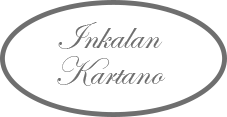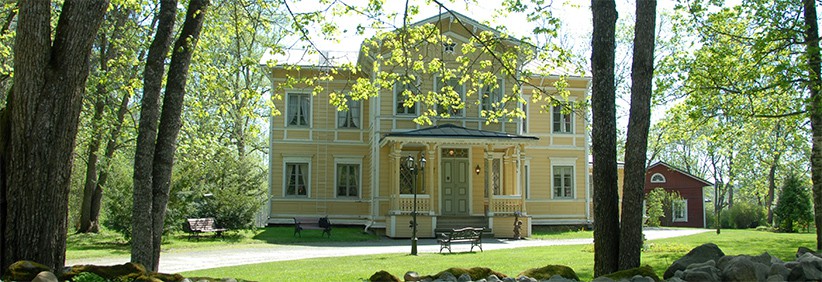Life in Inkala Manor between 1886 and 1903
Mrs. Arja-Leena Törrönen, née Puolakka, studied in Hämeenlinna teacher's seminar, and wrote a thesis concerning Inkala Manor. Here is an excerpt from Mrs. Arja-Leena Törrönen's thesis:
Life in Inkala Manor during the ownership of O. Heikel, between 1886 and 1903
I had the privilege of meeting doctor Heikel's daughter Mrs. Mila Schildt in her beautiful home in Eira, Helsinki. Listening to her, I got a glimpse into what life in the manor was like in the late 19th and early 20th century. As her words swept over me, I could see Inkala come to life before me.
Back then the manor grounds weren't as open as they are now. The manor yard was fenced in and had a gate. Children would rush in to open gates along the road to the manor, as guests were coming in, hoping to earn a few coins for their trouble.
The view overlooking the yard was not too different from today (in 1961). The most important buildings was the light coloured manor house, the red fence and the staff quarters. The garden was quite different from today's simple park styled garden. The old garden was characterised by grand plantings of roses, lilacs and jasmine, which were part of the old-world style. Another difference was the lakefront bathhouse, which had three sides surrounding a boarded swimming area, blocking the view from the beach.
A dozen servants
Doctor Heikel and his family only lived in Inkala during the summer. As soon as school ended for the summer, the family would move out into the country, to Inkala. The children loved getting out in the country, enjoying all the freedoms and joys of country-life. His work would keep Dr. Heikel in Helsinki, and he could only spend the weekends in Inkala, but after Midsummer he could spend half the week in Inkala.
Life in the manor was a bit more busy at the time. The staff was quite large back then, because all the work would have been done by hand. During Heikel's time, the staff had around 12 people, and many had families. They would live in the staff quarters, built next to the manor. The building would have a large common room, where they would cook and do their evening chores. Staff meals and work-times would be announced by the large dinner bell, which still hangs in the same place.
Mrs. Schildt told me, that the biggest events for the staff were the Hämeenlinna evangelical festivals. They'd be the talk of the entire staff for days leading up to it, and when the time came, they would leave early in the morning for the 13-kilometre walk into town. They would tie up their shoelaces and hang their shoes around their necks, walking barefoot for most of the way and putting their shoes on a couple kilometres before coming into town. The festival would last a couple days, and you'd stay overnight with family and friends in town. People would still talk about the festival for a long time afterwards – on the way back, while working and in the common room.
Cows and horses
The children got on well with the staff children, and would play together on the manor grounds. Memories that have really stayed with Mrs. Schildt include the large lime trees behind the manor house, which are still there, and the arched bridge crossing over a small rapid, which is now gone.
The family's children became familiar with many farm chores watching the staff work. Mrs. Schildt said, that she could milk cows at the age of ten, and she had named four of the farm's cows. The manor byre had plenty of livestock. There were around 25 cows and ten horses. The family had around 90 cows all together, but the rest of the animals were kept at the Laurila and Siironen farms, which Inkala bought in 1893, resulting in 882.5 acres of collective land.
Inkala saw plenty of visitors, as they kept in touch with other manors and families around the area. Their circle of acquaintances included, among others, Colonel Hugo Standertskjöld. He owned Karlberg manor between 1882 and 1926, the surroundings of which he made into Aulanko National Park. Mrs. Schildt told me that the children would often get to ride carriages into Karlberg.
A Happy Childhood
When the manor children started growing up, they often invited friends their age to Inkala. The sound of happy children would be heard all around. They would often have picnics around the manor grounds and take a small sailing boat and visit one of the islands.
During late summer, one of the children's favourite past-times was catching crayfish. The narrow Alajoki running through the manor grounds was a rich source of crayfish, and early autumn crayfish parties were common.
Mrs. Schildt's story is full of feelings of harmony and happiness, reflecting life in a manor house at the turning of the century, seen through the eyes of a child. Mrs. Schildt did mention, she considered Inkala her childhood paradise.
The manor moves into Baron Standertskjöld's ownership
In 1903 Dr. Heikel sold Inkala and Laurila farm to Baron* Karl Henrik Johan Standertskjöld, who already owned the nearby Kirstula manor, and he held it in his posession until 1924. The estates owned by Baron Standertskjöld included Kirstula, Tiirinkosti, Inkala and Laurila, which he later sold to Hattula municipality. The Baron didn't live in Inkala himself, letting the manor fall into some disrepair. During his ownership, Inkala was often a site for parties, and the second-floor hall saw many grand balls take place. During this time, life in the manor was immersed in luxury, but already showed signs of degradation to come.
Ownership under Juho Alkio 1924 – 1931
At the end of the 19th century, many mansions were moving under the ownership of landowning families. Inkala changed ownership to Juho Alkio in 1924. During Alkio's ownership the manor did not see many improvements. The buildings and fields were in a bad state, nor were the manor finances handled any better generally. This was result of Juho Alkio's many poor financial decisions. He sold off many of the manor's buildings, which he later regretted and suffered financial losses.
During an inventory taken in 1929 the manor had quite a lot of cattle. Inkala had some 35 cows and 9 horses. The manor had 80 acres of fields, mostly hay (46 acres) and oats (18 acres). They also had 200 acres of forest. All in all, the manor grounds totalled 308.5 acres.
Because of his financial troubles, Alkio was forced to sell the manor in 1931. After then it was owned by the sea captain J. A. Lahtinen, and his wife Helga, née Weckman. They begun to renovate the manor in 1938, when the main building was renovated both inside and out, and central heating and electricity were installed.
In an inventory taken in 1946, the manor grounds totalled 283 acres, 85 of which were fields. The livestock numbers were quite similar, with 30 cows and 7 horses. Later, the manor grounds became smaller due to land being assigned to refugees after the war.
*His actual title, 'vapaaherra' (“Free Lord”), is a rank of nobility equivalent to a British Baron or a German Freiherr
Sources: Kansallinen elämänkerrasto, Porvoo 1934; Suomenmaa IV, Helsinki 1922; Suomen maatilat, Porvoo 1931, Interview with Mrs. Mila Schildt
SCHILDT DISCUSSES HER CHILDHOOD IN INKALA
- Arja-Leena Törrönen interviewed Mrs. Mila Schildt in Helsinki in 1961.
- Mrs. Schildt was daughter to Dr. O. Heikel, and spent her childhood in Inkala. Schildt was born in 1885, so her story presents a viewpoint of manor life at the turning of the century.
- The Heikels were originally a middle-class family from the village of Oulunsuu, part of the larger Oulu province. The family ancestor Jaakko owned the Heikkilä house at the beginning of the 18th century. The famed doctor O. Heikel was a younger representative of the family.


